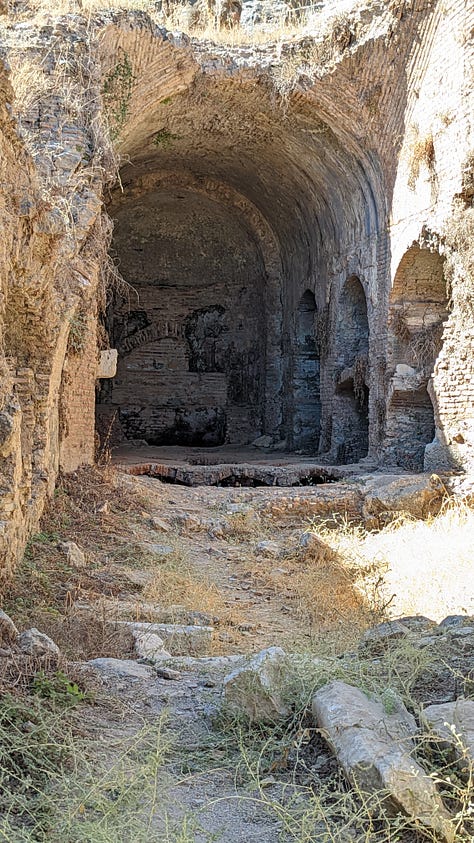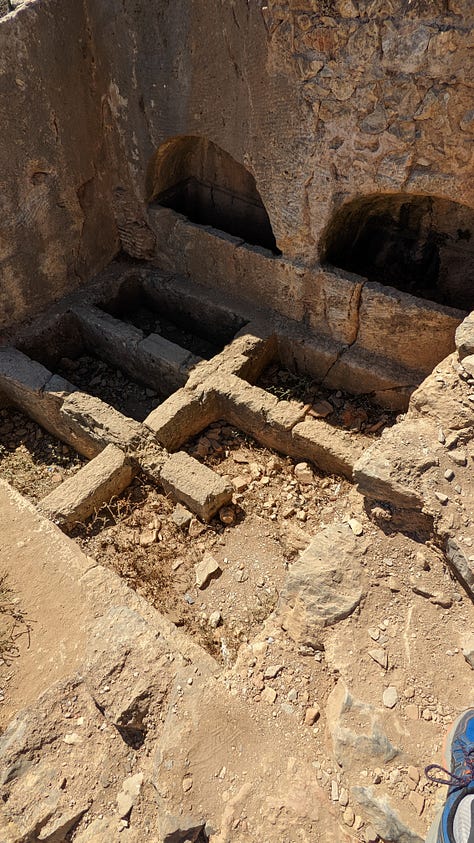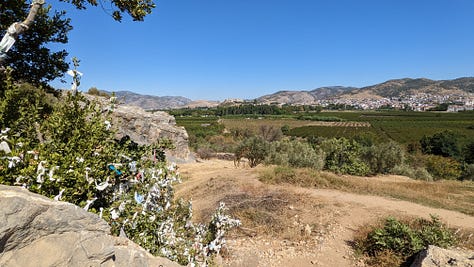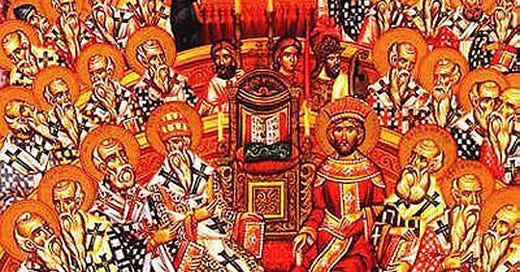Nicea, Part 3: Christianity at a Turning Point
The Council of Nicea (325) created a creed that has encured 1,700 years. But the directives formed there, known as canons, provide fascinating insights into early Christianity.
Near the ancient city of Ephesus lies the Cave of the Seven Sleepers.
Surrounding a natural cave near the base of Mount Pion are an array of crypts and the foundations of chapels: a place revered by Christians for centuries. The site overlooks the Sacred Way, a road connecting the seven-wonder-worthy Temple of Artemis with the southern gate of the city, along which notable citizens were buried before the Christian Era.



An interesting legend accompanies the Cave of the Seven Sleepers.
During the rule of Emperor Diocletian (282-305 CE), a wave of persecution roiled the empire (a wave directed, in part, by the oracle at Didyma). Churches were closed. Clergy were arrested. And in Ephesus, seven young men fled the city and hid in a cave, where they fell asleep.
When the boys awoke, they immediately thought of the persecution and wondered about the fates of family and co-believers. One boy volunteered to go into Ephesus, gather news, and bring back food for his hungry friends.
When the boy entered the agora to buy food, the vendors were shocked by the money he offered.
“These are Diocletian coins,” they told him, looking at the emperor on the coins. “He’s been dead nearly 20 years. Constantine is emperor now.”
Twenty-five years had passed while the boys had slept. Not only had the persecution ended. Christianity now carried the endorsement of the Roman emperor. While the seven sleepers had slumbered, the world had changed, and their story captured the suddenness of that change. (Similar “sleeper” stories are told in the Quran, the Indian epic, the Mahabarata, and even in American writer, Washington Irving’s “Rip Van Winkle.”
The boy returned from the agora to share the good news — and the food — with his fellow sleepers there (some accounts include a faithful dog). They celebrated the new, Christian world into which they had awakened, joined by believers from Ephesus.
When the revels ended, the boys fell asleep, and this time, they didn’t awaken. Ephesian Christians venerated them, and built tombs along the hillside next to the Seven Sleepers. For the Ephesians believed that the sleepers would certainly wake again in the resurrection of believers on Jesus’ return, and they didn’t want to miss it.
The Council of Nicea: a Religion in Transition
This month I have been writing about my visit to Iznik, Turkey, to honor the 1,700th anniversary of the Council of Nicea, the first worldwide council of Christian bishops, who met in 325 CE at the behest of Emperor Constantine to find unity on several issues that endangered the unity of the Church.
Constantine had reunited the empire just a year earlier. Though the Church now had a firm foundation in the empire it faced an uncertain future due to competing views of the nature of Jesus Christ — the predominating vision being the reason for the Nicene Creed that was developed in St. Neophytos Basilica, which lies today under the waters of Lake Iznik, 200m from the western gate of the walled city.
There were other issues faced in Nicea in 325. These ended up in the official record of the conference as directives or “canons” to local church districts known as bishoprics. They didn’t endure 1,700 years like the creed did — modern Christians will find some surprising — but they provide a fascinating look into the Church at a crucial time in its history: the Apostolic Era of leadership by Jesus’ students or disciples and their students was nearing an end, and the Church faced a sudden influx of millions of Roman citizens who may not be “true believers” but rather those who wished to benefit from connections to the state church. This influx would threaten the orthodox views so rigorously defended during the first three centuries of the church’s history.
The Easter or Paschal Controversy
Another way that the Council of Nicea sought to unify the churches in Christendom was over the celebration of Easter. This debate has particularly close ties to Izmir, known at the time by its Greek name, Smyrna, so I will describe it first.
The Jews celebrate Passover every year on the 14th day of their month, Nisan (which also happens to be the name for “April” in Turkish). This coincides with the new moon closest to the spring equinox.
Jesus and his students met in an upper room to celebrate this feast on a Thursday evening, the night before His death. The day of Passover wasn’t fixed on a particular day of the week, though, it was always on Nisan 14, whether it was a Sunday, Thursday, or Sabbath. Because of this, Jesus’ death has been traced to April 3, 33 CE, the day after the Nisan 14 Passover celebration that year, making the first Easter Day two days after that: April 5.
The first Christians celebrated the Paschal Feast on Nisan 14, just as Jesus and his followers had done. In addition, they also celebrated a second feast the following Sunday in honor of Easter.
As Christianity spread among gentiles, the Passover Feast and the Easter Feast began to merge, and the focus of Holy Week moved to Easter Sunday, not Nisan 14.
A fascinating episode in this debate dates to 160 CE, when the Bishop of Smyrna, Polycarp, journeyed to meet with his colleague, Anicetus, the Bishop of Rome. The latter bishop hoped to convince Polycarp to accept the Easter Feast and forgo feasting on Nisan 14, thus joining the majority of Christian churches in the empire.
In response, Polycarp cited St. John, Jesus’ disciple, who had been Polycarp’s teacher in the Christian faith. He also had the teachings of St. Philip another disciple, who had been martyred not far from Smyrna. These founders of the faith had told Polycarp to worship on Nisan 14.
Anicetus had no answer. The church at that time was — as the Nicene Creed asserts — “one, holy catholic and apostolic,” meaning that its leaders traced their authority to the original followers of Jesus, who had passed down orthodox teachings through their followers. Anicetus and Polycarp had similar ecclesiastical authority — both were bishops — but Polycarp had apostolic authority from his teacher. Anicetus and Polycarp parted on good terms, but they reached no agreement.
By 325, the Easter Feast had grown even more popular, but the Paschal Feast on Nisan 14 still held sway in Smyrna, Ephesus, and southwestern Anatolia — the areas where Polycarp and John had ministered.
Constantine stepped in to resolve the controversy. He decreed that the Easter Feast should fall on the first Sunday after the first new moon that followed the spring equinox. This moved the feast from Passover Day to Easter Sunday as the western Christians had asked, but it also hewed somewhat to the Jewish month of Nisan, which was also based on the first new moon of spring.
This set the standard for Easter celebration which continues today (I understand there is a difference between eastern and western Easter celebrations, but I won’t get into that here). No doubt Christians in Smyrna celebrated a feast on Nisan 14 for a time after the council, but the practice died out.
The 20 Canons of Nicea
Along with resolving the Easter controversy, the council set forth directives for the regional churches. The bishops who gathered in Nicea no doubt foresaw the dramatic changes that would affect Christian churches who were now in league with the state, not in opposition.
To maintain orthodoxy and preserve the moral authority of the Church, the council wrote 20 canons, directing bishops on how to manage clergy and accomodate new and returning Christians — including those who were returning from heretical sects like the Arians or who had lapsed in their faith to preserve their lives during the recent persecutions of Diocletian.
I have broken the canons down into three categories, based on the order of authority they were addressed to: metropolitans (heads of multiple bishoprics), clergy (bishops, elders and deacons) and laity.
Metropolitans
Canon 6 (C6) set up three metropolitans or archbishops, who were based in Alexandria, Rome and Antioch (in that specific order. The Alexandrian church was the most influential at Nicea, as that was the church from which Arius had come, and it was the church most fervent in fighting Arianism). A subsequent canon, C7, added the city of Aelia Capitolina (formerly known as Jerusalem) to the list of metropolitans. In these three divisions, one sees metropolitans governing vast episcopal territories consisting of Africa (Alexandria), Europe (Rome), and Asia (Antioch).
The council also recommended twice-yearly synods of bishops in each ecclesiastical province — one just before Lent and one in the autumn. These meetings helped churches craft common policies regarding excommunicated Christians and new teachings (C5). While the bishops were elected from among the church leaders in their areas, the metropolitans were to ratify these appointments (C4).
Clergy
The clergy was expected to be “blameless” in the eyes of the communities they served (C9). To achieve this, bishops, elders (local church leaders), and deacons (responsible for the physical needs of the church and its members) were barred from living in the same house as a female servant or any other non-familial woman (C3). Clergy were banned from loaning money to members, even at a low interest rate, in C17.
For those clergy who cleansed temptation by self-mutilation, C1 barred castration among the clergy, although it allowed for those who had been castrated before becoming leaders in the church. C2 recommended the careful vetting of new members before they became church leaders in order to preserve the blamelessness of the clergy.
One aspect of the early Christian Church that comes to light under these canons is how localized the churches were run. The pastors (known as elders or presbyters) of churches were often members who had grown up within the churches that they led, reaching their positions from lifetimes of fortitude and service. Deacons were local as well. Bishops, therefore, were also natives of the districts that they governed.
Arianism had thrived after Arius’ expulsion from the Alexandrian church because its founder had found a new church home in Nicomedia (modern Izmit, Turkey) and its influential bishop, Eusebius. C15 barred all clergy from moving to new cities or from moving from one church district to another. A clergy who tried to change churches was to be excommunicated, per C16.
Finally, C17 barred deacons from administering the Eucharist. This was a role only for the elders and the bishops. This shows the importance of this sacrament and the authority required to give Christ’s body and blood to believers.
Laity
The remaining canons addressed matters related to the laity or common members of the church. They reflect two interesting aspects of the Church in the early 4th Century. First, Christians were returning from heretical sects and moral failure, and the council sought to manage their readmission into the church. Second, canons describe the lengthy process that people must go through to become Christians and partake in the Eucharist at fests.
Bringing heretical sects back into the fold
Among the recent heresies addressed in the canons is a movement that had arisen in Rome around 250 CE. Calling themselves “the pure,” these churches refused to re-admit Christians who had renounced their faith in times of persecution or had back-slidden morally. The founder of the sect, Novation, had broken away from the catholic church and had been named bishop of a few breakaway churches. The mainstream church had created processes by which lapsed Christians could return (see below) and now sought to bring “the pure” back into the fold as well.
Another heretical sect was the Paulicianists, followers of a breakaway bishop who had taught that Jesus was a man, not part of the godhead. (The over-arching theme of the Council of Nicea and the Nicene Creed had been to defend the doctrine of the Trinity.) Unlike the Novationists, C19 required re-baptism for believers returning from the Paulian sect and, presumably re-training in Christian teachings.
C19 is the only directive that explicity addresses women in the church. Many churches had women supporting the local churches and ministering to the poor. These were known as “deaconesses.” But despite the feminine comparison to “deacons” who were members of the clergy, C19 stated emphatically that these women were to be numbered among the laity.
The lengthy process of readmission for lapsed Christians
Despite the fact that the Council of Nicea was chaired by the Roman emperor and represented a religious movement that was on the verge of becoming not just popular but dominant in the empire, the bishops emphasized the exclusivity of Christian membership and set up barriers to the Eucharistic feast for those who sought admission.
This is a shock to American Christians, in particular, where recruitment is prioritized in a church’s mission, and “successful” congregations may number in the thousands. The Church Fathers at Nicea, as those before them, saw Communion as a ceremony meant only for fit, “blameless” members of a community. Recruitment — as well as reinstatement — required two steps before baptism and the chance to join the community with full membership:
Hearers were allowed to sit apart from the believers — in many cases, outside the meeting house — and listen to the scriptures and the teachings. They had no role in the service, not even for prayer.
Prostrators were allowed into the service to hear the teaching and to pray. They had the same status as catechumens who were actively studying to join the Church through baptism. They were allowed into the worship hall and took part in hymns, prayers, and scriptures. But they were dismissed from the house or hall before the Eucharist was served.
Communicants were full members in the Christian community who took part in the weekly Eucharist. Those communicants who were most devout were admitted to the clergy.
Clergy had passed through all three previous steps. They were carefully vetted for past sins (C9) and could still be deposed by a council of bishops if misdeeds came to light (C10)
Readmitting lapsed or breakaway Christians relied on this three-stage process of admittance to the Eucharistic ceremony. The Novationists — who hadn’t broken theologically with the Church — were readmitted as communicants, or as clergy if the local bishop could find a place for them. The Paulicianists were demoted to prostrators/ catechumens and had to undergo re-baptism into the orthodox church before returning to the Eucharist.
This framework also explains two canons that managed lapsed Christians. C11 allows Christians who had left the faith during persecution to return after serving three years as hearers, seven years among prostrators, and another two years among “prayers”1 before they could receive communion, 12 years in all.
C12 addressed Christians who had returned to military service. A great antipathy towards soldiers is evident here — remember, fewer than 20 years had passed since the last persecution of Christians, and the memories of sodliers leading believers to their deaths were still fresh. The canon addresses those soldiers who return to their posts “like dogs to their vomit” and gives them sentences of 13 total years (three as hearers, seven among prostrators, and two futher years among prayers) before they could receive the Eucharist.
Finally, lapsed catechumens who had left due to moral failings were given three additional years among hearers before they could continue their study towards baptism (C14).
Mercy still held sway, even for lapsed Christians. C13 allowed last rites to be administered, should any lapsed Christian be at the point of death, whether they had served their sentences or not.
Why I Found the Canons Interesting
As the Nicene Creed states, the Church Fathers who met in Nicea saw themselves as part of a universal church that was united, holy and apostolic. While politics were no doubt part of the proceedings, the council blended mercy towards breakaway sects and lapsed members with rigid orthodoxy.
For example, the Christians of Smyrna and Ephesus had the moral high ground on the Easter Feast. St. John himself, Jesus’ own ‘beloved disciple,’ had told them to hold a feast on Passover evening and another one on the following Sunday. Constantine had settled the matter himself, yet the Quartodecimatists (those who feasted on Nisan 14) weren’t expelled from the church at Nicea, nor were their practices banned. (As a resident of Izmir, my biases are towards these Smyrnian Christians.)
The privilege of Church membership is also evident throughout the canons. Membership began in the local church, and it stayed there for life — whether one were a communicant or moved up among the clergy. Switching congregations was banned — particularly for clergy — and a commitment was for life (I’m sure that moving from city to city was rare in the 4th Century).
It was hard to become a Christian, requiring many years of study and service. And moral failings — sexual immorality, usury, or participation in the military — yielded stiff penalties and demotion among the faithful.
At my church in Izmir, Communion has a special place. A typical service will have members, a few visitors from other countries, and a handful of local Turks curious about what goes on in a Christian service. There are no “hearers” who are kept outside to listen.
Communicants from all denominations are welcome, but the Eucharist is restricted to members. Visitors who come forward but are not Christians are given a blessing by the pastor at the rail where members kneel to receive bread & wine. Candidates for baptism must wait six months or more until baptism, usually at Easter, an they may not partake in the Eucharist. This year the catechumens had to wait a few additional weeks until their baptism was confirmed by the bishop at a special service in Istanbul!
I remember the protestations of a young Turkish woman who wished to join the church. “I want to take Communion,” she told me. She had been coming to church for several months. “I don’t want to wait.” To be honest, I haven’t seen her for a few months, and she may have grown tired of the delay.
As I finish this essay, I return to the idea of the Seven Sleepers of Ephesus. I imagine one of the 318 Nicene bishops awakening in 2025, 1,700 years after the council. What would he think about the Church today?
People dressed in strange garb. A woman may play a significant role in the service. At a church like mine he may encounter a group more diverse than the one he met in Nicea.
He would recognize the Creed. Yes. And he would worship with us on Easter. That too.
But I wonder….
Other essays in this series on Nicea:
I cannot figure out what distinguished this role from the catechumens. If you have feedback, I’d appreciate a comment.



